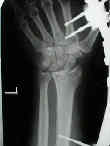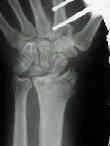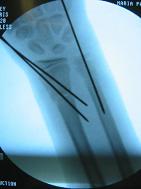- Discussion:

- children's frx are rarely intra-articular;
- common types:
- physeal frx
- torus fracture
- green stick frx
- both bone forearm frx
- galeazzi's frx
- distal radius fracture:
- Anesthesia:
- note that in children, the term "IV sedation" should be changed to "IV anesthesia," since any amount of IV sedatives are potentially dangerous;
- determine when the child last ate;
- realize that a painful fracture can cause a gastric ileus, and therefore, waiting 8 hours before administering IV anesthetics does not at all guarentee that
the child's stomach will be empty;
- Closed Reduction:
- note: completely displaced fractures are 7 times more likely to redisplace than fractures with some bony contact or no translation;
- technique:
- pure traction may actually make it more difficult to oppose the frx ends due to tightening of the overlying periosteum (like a chinese finger trap);
- distal radius is hyperextended and the distal fragment is pushed distally until the dorsal cortex is out to length;
- distal fragment is then "hinged over" the frx site;
- if closed reduction is still not possible, then insert a 1 mm K wire percutaneously into fracture site and use it "lever" the fracture into a reduced position;
- reference:
- Closed reduction of fractures of the proximal radius in children.
- Distal Radial Fractures in Children: Risk Factors for Redisplacement Following Closed Reduction
- Acceptable Reduction:
- see accetable reduction in both bone forearm frx
- references:
- Remodelling after distal forearm fractures in children. II. The final orientation of the distal and proximal epiphyseal plates of the radius.
- Remodelling after distal forearm fractures in children. III. Correction of residual angulation in fractures of the radius.
- Remodeling of angulated distal forearm fractures in children.
- Translation of the radius as a predictor of outcome in distal radial fractures of children.
- Risk Factors in Redisplacement of Distal Radial Fractures in Children.
- Think twice before re-manipulating distal metaphyseal forearm fractures in children
- Immobilization of Distal Radius:
- references:
- Immobilisation of forearm fractures in children: extended versus flexed elbow.
- Above and below-the-elbow plaster casts for distal forearm fractures in children. A randomized controlled trial.
- Comparison of Short and Long Arm Plaster Casts for Displaced Fractures in the Distal Third of the Forearm in Children.
- case example:

- 2 yr old male who sustained a simple distal radial torus frx;
- he was treated w/ a sugar tong splint, was sent home, and cried all night;
- several days later, it was apparent that he sustained a 3rd degree burn to the forearm, as well as a Volkman's ischemic contracture;
- Operative Treatment:
- note associated injuries: - condylar and supracondylar frx;
- w/ bayonete opposition, the child should receive general anesthesia with closed reduction and pin fixation;
- if closed reduction is not possible, then insert a 1 mm K wire percutaneously into fracture site and use it to "lever" the fracture into a reduced position;




- references:
- Compartmental syndrome complicating Salter-Harris type II distal radius fracture.
- Growth disturbance of the distal radial epiphysis after trauma: operative treatment by corrective radial osteotomy.
- Redisplacement after closed reduction of forearm fractures in children.
- Completely displaced distal radius fractures with intact ulnas in children.
- Management of completely displaced metaphyseal fractures of the distal radius in children. A prospective, randomised controlled trial.
Pattern of forearm fractures in children.
Use of pins and plaster in the treatment of unstable pediatric forearm fractures.
Team physician #5. Salter-Harris type I fracture of the distal radius due to weightlifting.
The Management of Isolated Distal Radius Fractures in Children.
Open fractures of the forearm in children.
- Complications

